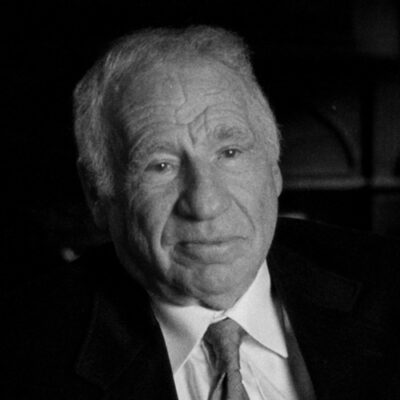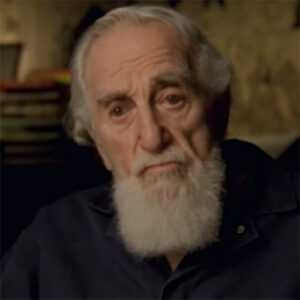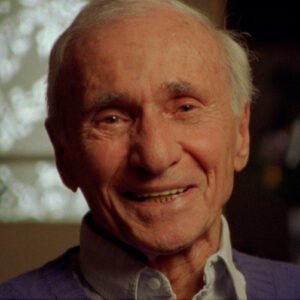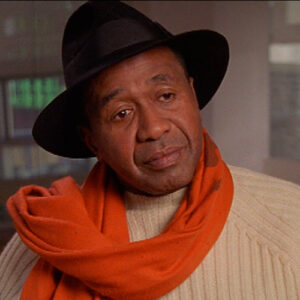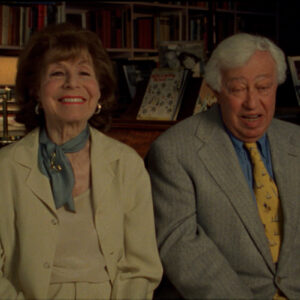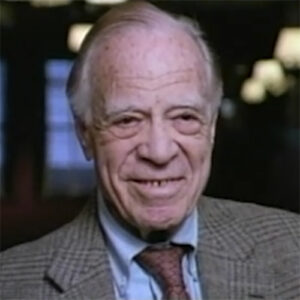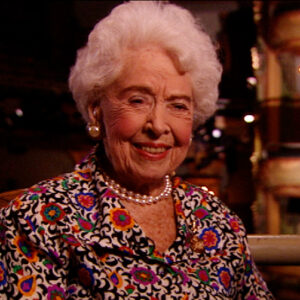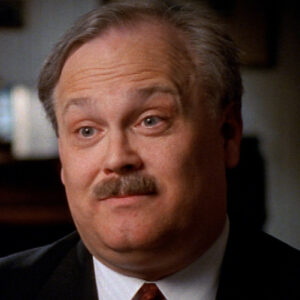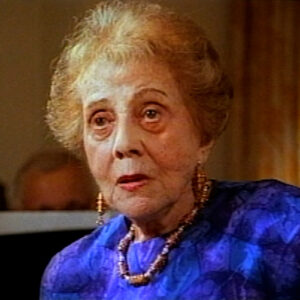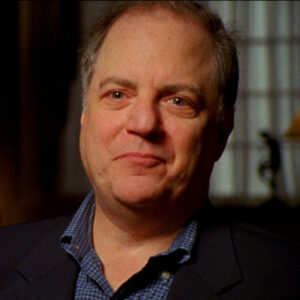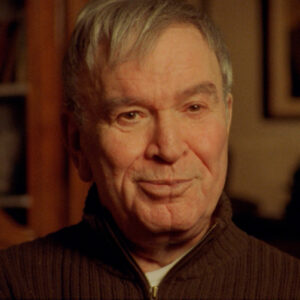Interviewer: Come from nowadays? That’s just a big question because you have the big corporate type shows and then you have sort of anomalous things that come from off-Broadway.
James Lapine: Well, I think Broadway musicals seem to come from different venues these days. There was a sort of brief moment where, I know with Live Ent, they became kind of packaged in a way. Someone had an idea for this and called up a writer and a composer and a lyricist and put them together. But I would say the majority of them seemed to be artist-driven and composers and librettists who have ideas that they want to turn into musicals. There are so many musicals that are being written without the projection of production at the point, which I think creates for an interesting body of work. But I think it seems that the musicals today are kind of coming from all different directions. Some are being producer-driven, I think now with so many coming out of being based on movies, that we’re seeing the… Film companies are actually starting to generate a lot of productions of musicals. They’re going into their libraries and contacting writers and composers to see if they would adapt their films to the stage. So in a sense, I think it’s beginning to change a little bit where musicals are beginning to be.
Interviewer: Let’s talk about Sunday. How did you sort of, what struck you about Surat’s painting and how did the juices get flowing in the genesis of the project?
James Lapine: Well, I started as a graphic designer and a photographer, actually, and just by fluke, directed a little show in New Haven when I was working at the Yale Repertory Theater as a graphic design. And the painting, Sunday on the Island, La Grone Shot, was just one of my favorite images. At the Yale school, they have a sort of January work month where they ask everybody to do something out of there. Their own particular field. So my students, as I was teaching at the time, said, why don’t you direct a play? So I said, find me one, I’ll direct it. And they found a little Gertrude Stein play called Photograph. And so I employed basically, it was only a three-page poem that turned into an hour and a half evening. So I employed kind of well-known images, one of which was the Seurat. So when I happened to be introduced to Steve Sondheim years later and started moving into the theater, we were looking for a project to work on and that particular painting had stayed with me and became the sort of inspiration for our show, Sunday in the Park with George.
Interviewer: So in the first conversation you had with him about it, what did you say, just briefly?
James Lapine: Well, when Steve and I first started talking about ideas, I actually brought in a bunch of images. And one of the images was that painting. And I don’t have great memory for these things, but somehow that sort of sparked us. And I think I just went off and started writing. I didn’t really have any grand plan for that show. I just actually remember sort of plopping up the a little postcard of the painting in front of the typewriter and just kind of sitting down and just sort of re-associating on the painting and that’s kind of how it was born. And as Steve and I were looking at it, you know, I said, well, these are all the characters. So it was kind of already a proscenium filled with characters waiting to be brought to
Interviewer: What is Sunday in the Park about?
James Lapine: Sunny in the Park, well, depends who you talk to, is about a lot of different things. I mean, I would say probably the most central theme of it is art and life. And certainly for the character of Seurat, his art was his life and his paintings were his children. And I think for many artists in all fields, that is sort of applicable. But it’s also, I think, about how art feeds life and how that painting fed the other characters in the piece, specifically his great-grandson, and also how it obviously fed the people who wrote it.
Interviewer: Could you just tell me briefly how you structured it?
James Lapine: Well originally when we worked on Sunday it was three acts and it actually followed the life of the painting for a hundred years. But it was a pretty ambitious show to write something of that scale. So what happened was basically conceptually it became a two act show and we just skipped hundred years. But originally, the idea for it was to actually follow the life of that painting, which it had an interesting life of its own.
Interviewer: You said it was an ambitious show, but it wasn’t originally intended for Broadway, was it? I mean, it was… Tell me about what Stephen Sondheim, what his mindset was like at the time, because he had just come off of very early. How was he feeling about Broadway?
James Lapine: Well, I had just met Steve Sondheim at the time, and I know having just had a fairly unpleasant experience with Merrily We Roll Along on Broadway, he was about to embark with a new collaborator. And I had never been on Broadway. I was really a downtown kind of guy. So I don’t think Broadway was ever something I thought about for the show. It was basically just writing the show, and I had a small commission. Playwrights Horizons at the time, and so that’s how I met the commission was by writing that show and we did a little workshop of it. Sometimes Broadway is just an inevitable destination for a show just by virtue of how many people are in it and how large an orchestra it demands because off-Broadway can’t support that economically, and I think that’s basically what happened with And it’s really curious because when we went to look at Broadway theaters, I was so intimidated because I had never worked in anything larger than 150 seats. So I sort of insisted that we go over to the Boo Theater, which is the smallest house on Broadway, which in retrospect was just ridiculous. I mean, you know, it’s much too small a theater for that show, but to me it seemed huge at the time. And the producers, I have to say, to their credit were… Wonderfully supportive, even though economically it made no sense.
Interviewer: But is it true that Sondheim wasn’t thinking about this as a Broadway show? I mean, you said you’d never had a show on Broadway, but this is even Sondheimer.
James Lapine: The irony is I didn’t really start in the theater. So I mean, I, of course, had heard of Stephen Sondheim, but when I met him, I’d actually only seen one show of his, which was Sweeney Todd. So I was sort of naive about the whole mindset of Broadway versus off-Broadway. And I was still in the mindset, well, this is kind of a lark, and when this doesn’t work out, I’ll go back and be a graphic designer. So I didn’t make the distinction of Broadway versus Broadway. I don’t know. What his thinking on the subject was. It wasn’t something we actually sat down and discussed. We just worked on the show. We didn’t say, oh, well, let’s sit down and write a Broadway show. It was just organic in the way that it came into being. And it was never discussed where it was going to be presented, other than the fact that I had asked that we could do a workshop of it at Playwrights Horizons, which, as a 150-seat theater, must have been a bit of a shock. To Steve to go from such large venues to such a small one. Well, the only other musical I had done before Sunday was March of the Falsettos, which was a sort of strange, wonderful collaboration with William Finn, in which we kind of created it on its feet. Bill had already done a sort-of prequel show called In Trousers, and we sort of had the characters, and I sort of came in as director and then kind of helped shape the story, but there was no actual book. So beginning to work with Sondheim was a great education because I hadn’t written, not only had I not written a book for a musical, I’d only directed one other one. I actually only directed a few other shows altogether. So in a way I think it was a good collaboration because here was someone with enormous knowledge and experience in the field working with someone with basically very little, if no knowledge. And so it was wonderful balance. I learned so much. About structure and routine and all that from Steve. And I think in some ways, I’d like to think anyway, it was kind of liberating for him to work with someone who didn’t have a common frame of reference for shows. So I wasn’t saying, oh, let’s make it like this number in that show or this number in that show because I just didn’t have that frame of So I was coming from a kind of very abstract sense of of what a show should be. And I think that was interesting. I remember the first numbers. I was so amazed. I just wrote a couple of scenes, and I would bring them into Steve. And he would kind of lie on the couch and kind of read them and kind of scrawl on his little soft pencils. And the first number is Sunday in the Park with George. He said, I think should go right here between this line of dialog and that line. He said, you know, I think we need to relax the audience and let them know it’s not gonna just be Artie that will give them a kind of welcoming number, which it was. That was a kind of great show-stopping kind of number that that character has. But I had written, she steps out of the dress, and I had kind of put in these kind of really weird visual things, which I thought would be fun, and he wove it into kind of a great number. So that’s kind of how we worked. You know, the nice thing about a collaboration is you don’t really remember who thought, I don’t remember anyway, who thought of what or how an idea came to be. You just kind of, like a ball player, get into a zone where ideas just kind of flow and it’s not something I find that I want to be that conscious of. And it’s wonderful to collaborate with Sondheim because he has such an incredibly fertile imagination and is so open to the exchange of ideas end. Bring so little ego to the process, and is so there to support your work, you know, and to take what you give him and make it shine at the same time. You obviously want to give him as many opportunities to create the brilliant songs that he makes.
Interviewer: We have great stuff about Sondheim discussing how he did the music, which is so amazing. Could you just comment briefly on the innovation that he brought to that show musically?
James Lapine: Um…
Interviewer: Or perhaps you can tell me the most sort of powerful moment for you in the show.
James Lapine: One of my great memories of doing Sunday in the Park was, well actually there are two sort of general ones. One is when we were at Playwrights Horizons and Steve brought in the song, Finishing the Hat, which Mandy Patinkin, in his great spirit, said, I want to perform it tonight. It had just come in and he wrote it on the sketch pad that he was sketching in the show and sang that song. And it was just one of those moments that’s magic when a show comes together when that song at that moment, sung for the first time, to an audience, I think audiences just have a kind of sixth sense for those theatrical moments that they know only they are present for. And that song so crystallized the whole purpose of the show that it was electric. The audience just erupted at the end of that show. And I think it just touched people. And I think it came from an extremely personal place. For Steve and I think for anyone who’s tried to do anything creatively. So that was kind of a great, great moment. The other thing that was difficult was we went into Broadway without a completed score and particularly in the second act. So that preview process was the hardest thing, one of the hardest after Passion that I ever went through because we didn’t have finished material. And I had put in monologs. I had written several monologs. For the show with the expectation that Steve would then turn them into songs, and we had to perform this on Broadway with these monologs, which, you know, is rather peculiar in a musical. But it was just, that whole Sunday process was just like watching a painting come together, particularly that painting, dot by dot, and as each song came in, as each lyric came in, the picture became more focused and the storytelling clearer. It literally didn’t come together until, oh, I think, a day or two before the critics arrived. I remember we did the last song, which I believe was Children in Art, with just a piano accompaniment. But you could, for us, I mean, there are those who like the show and those who don’t or whatever. But for, as creators, it was just such a thrilling moment to see the picture come into focus and know that the vision that we had for it had actually been realized.
Interviewer: Finishing the half, can you just tell me briefly, what is that song about, what’s happening?
James Lapine: I have to say, it’s been 20 odd years since I wrote the show. And it’s funny, because sometimes you go back and see something. I remember watching TV one day on a Saturday. And I’d just gotten off the phone with Steve. And he was working on a new project. And I was working another project, but not working together. And we were both at sort of a standstill. And I, as I do, go into the television, kind of And all of a sudden, Sunday in the Park came up on TV. It was being broadcast. And it was. Right at that moment in the second act where the young George is saying how lost he is and he doesn’t know what he’s going to do next and, you know, dot appears. And I remember calling Steve up and saying, gee, we wrote a message in a bottle to ourselves and we didn’t even know it. And in a funny way, of everything I’ve done, Sunday in the Park was sort of, on a certain level, kind of unconscious work, that came from some kind of place that was… A little deeper, a little less articulated in a way. And I feel on some level, for Steve, that’s true too in the music. It’s harder to do that in music because lyric writing is such an intricate art form and it’s a form of poetry and music as well, but Finishing the Hat seemed to me to come from some very deep place for Steve about the sense of joy of creating something out of nothing. And I think that’s what we do as a creative person does and I think it’s what that show is about. So, when finishing the hat… Kind of came in as a song, it spoke on so many different levels, not only to us, but I think to other people as well, how you can take a moment to admire that you’ve put something in the world that wasn’t there before.
Interviewer: Can you put the show, sort of, this is another big picture question, in the history of the Broadway musical, the evolution of the form, Stephen Sondheim was, you know, learned how to do this art form under Oscar Hammerstein, but he ended up going so far from that. Can you just sort of place Sunday in the big picture of the evolution in the musical? It’s a tough question.
James Lapine: I think Sunday in many ways is not, was not and remains in a way not a classic Broadway musical. I mean it’s a fairly peculiar show and I haven’t seen it in years, but I remember that the audiences were not prepared for it when we presented it. I’m not sure, I didn’t quite understand what people were having such a hard time because I was not a baby at the Broadway. Stage. So, you know, if you put it on down at the public theater or something, I don’t think anybody would bat an eyelash about it. But for some reason, that show is a little art, more artful, a little more abstract, a little stranger, a a little more impressionistic than musicals that people at least were used to seeing, or at least at the time we presented it on Broadway. In its greater context, I’m, I’m not sure. Where it stands, it almost feels like the musicals today are getting a little, going back to being a little bit of a throwback, you know, the sort of hair sprays and producers, which is not to say they’re not wonderful, they are, but the more ambitious kind of creative musicals are, I still think, remain kind of few and far between, particularly on Broadway.
Interviewer: Why is it important that there be a place on Broadway for the peculiar anomalous show, like something?
James Lapine: Well, like any art form, you kind of wanna hope that the form is being stretched, that people are going outside the box a little bit. Not that everybody should do that, because I think what you hope for, for Broadway, is a lot of diversity in terms of what’s offered to the public. And I think the thrill of going to the theater always is the lights go down and you hope to be transported somewhere and taken somewhere you haven’t been. And I think that’s the danger because it’s such an expensive venture at the moment that that always, unfortunately, makes people conservative. It makes producers and creators want to have to create material that they know will fly. And that, I think, often can inhibit you in terms of taking chances and trying to do something that maybe people aren’t used to or hasn’t been done before.
Interviewer: Could Sunday be mounted today on Broadway, do you think?
James Lapine: I think it would be hard to revive Sunday in the Park, sadly. I think would cost a lot more money. And I think we’d have to have stars. I think you would have to probably some draw personalities to pull people in. I’d like to think it could be done. I hope it could done. But at this moment, in this climate, I’m not so sure. I think I would probably be more personality star-driven than it would material-driven at this point. It doesn’t have a lot of the elements that people who are spending a lot of money, you know, are expecting.
Interviewer: You did two other shows with Santana, Passionate and Into the Woods. Is there a common thread to all three shows, something that sort of distinguishes your collaboration with them?
James Lapine: Actually, what I enjoy about looking at Sunday against Passion and against Into the Woods is that they’re three really different kinds of shows. And I think what was exciting to work with Steve on those three shows is that were just very different. Into the woods was a very conscious effort to do something that was intricately plotted and something that kids, a younger audience, would be engaged in. Passion was sort of, that was more driven by his love of that particular material, and that was sort an attempt to do something operatic, you know, really, and kind of very adult, sort of the opposite of Into the Woods. But again, it wasn’t sitting down and saying, OK, let’s do X or Y. It was just really a process of sitting down, and going, gee, what are you thinking about these days? What interests you? Oh gee, I’d love to explore this, I’d love to explore that, and you sort of settle on an idea that two people in a room can be passionate about for a couple of years, at the very least. It wasn’t working like so much like, gee, did you see, you know, this movie and let’s turn this movie into a musical. It was mostly kind of taking the temperature of where we were in our lives and how we’re feeling and what we wanted to and time thinking about. You do have to kind of sell your wares a little bit. I’m still doing it. I don’t think Steve’s still doing. And I mean, you still have to call the investor or the producer, and it’s hard. It’s unfortunate that I don’t think very few people have gotten to a place in their career where they don’t have to still kind of go out and sell their work a little. Oh, the number of putting it together, we did a couple versions of that. It really was a lot about, you know, as we were writing it, we were, you know, it really I think came, I think Steve has written about it before in Merrily We Roll Along about this idea of having to audition your work. And sadly, you now, even someone with incredible track record that he has still has to kind of do a little bit of, as he would call it, schmeicheling to get his work produced and to get it up. That’s an unfortunate part of what we do, particularly on Broadway. I think what’s nice about not-for-profit theater and off-Broadway is to a certain degree you have a little less of the salesman’s task ahead of you, at least in getting the work
Interviewer: Can you tell me that story about when you said, oh Steve, let’s just make this successful?
James Lapine: Well, when I first met Steve, he had, just unmerrily, we were all on Broadway, which did not have a long run at all, and was not particularly well received, and he was pretty much down in the dumps about, as anyone would be, you know, the situation of getting a show up on Broadway and keeping it running. And he had gone on a little bit, and as we all do, you we can sometimes, you know, look at the greater picture and going, well, why is that such a huge success and why is my show not, you now, kind of thing. I don’t remember quite the circumstance, but I was listening to all this and I had just met him and I was fairly new to the theater. And so naively I said, well gee, you, know, I’m sure we could sit down and. Think of a show that could be popular, and could be successful. And he kind of looked at me like I was crazy and said, I would never do that. And I think that’s kind of key to who he is in his work. And it’s been a big influence on me. I mean, you don’t project a show towards an audience. You write what you write, and people embrace it or they don’t embrace it. And that’s sort of also. What made George Seurat such a great character because he in his time was uh… Had no success whatsoever and on the contrary lived like a pauper and worked like a dog and uh… The irony of course is that you know he’s one of the great artists of all time uh… And i think Steve Sondheim just follows his own interests and his his own voice and lets the chips fall where they may. Well, in putting it together, the second act, George, has to hustle his work. And the song Putting It Together is a number of a cocktail party that follows the opening of his performance art piece. And he’s basically working the room. He has to work the critic. He has the work the head of the museum. He has work the people that are going to give him money to do his next work. It’s the other side of art, it’s the side of the business side of art, the art in which we are a commodity as much as our work is a commodity and how we have to promote ourselves as much we promote our work to get to get the next thing done to make a living.
Interviewer: And who conceived of the cardboard images of him popping up?
James Lapine: I don’t recall how the cutouts came to be. I think it was rather organic because we had, in the first act, the cutout soldier. There was a soldier and then a cutout of a two-dimensional soldier, really, that was carried around. So it was carrying through the theme of our personas and that you can take out your salesman and put him over here. And be conscious that you’re doing that at the same time you can’t keep your artist pure over here. And that’s kind of what putting it together is about is he’s putting together his next piece at the same time he has to kind of, in a sense. Removed and detached from what he’s doing, otherwise it would be a soulless.
Interviewer: The number of color and light, can you just tell me what’s happening in that number?
James Lapine: Color and light, I believe, is sort of two reveries. One is of George creating the painting and actually, in fact, painting his mistress in the painting, and reveling in the creation of putting these colors together to create a whole image. And a woman who’s sitting at her mirror putting herself together and powdering herself and creating her own persona. The artist, in fact. And that, of course, that image of Dodd at the mirror is based on a famous Seurat painting of a woman at a mirror. So color and light is just these two people who are very much in love with each other, but they’re also very much in love what they do. And in his case, it’s making art, this particular painting. And in her case, it’s make herself beautiful, making herself an object that wishes to be painted, to be remembered, to be someone to be loved and appreciated.
Interviewer: So many layers, it’s an amazing, amazing show. Tell me about directing this show. I just was watching the DVD last night and there was this moment where they, you take the, George takes the glasses off, they go right before the painting comes down, it’s like this little.
James Lapine: Right.
Interviewer: All right.
James Lapine: Again, the creation of a show like Sunday in the Park, it’s hard to remember where moments came from. I think the taking off of the glasses was just something that came to me at the moment. I don’t recall writing it, though I might have, but I think it came from casting a little girl who wore glasses, in that case, Danielle Furland, and then having the idea as I was creating it, oh, we’ll just take the There’s one unfinished thing going on in the painting. But again, collaborations are so ineffable in a way. And a lot of the times, I don’t remember how I came up with ideas, or how things got written, or who created or provided what idea here and there. And I think that’s what makes a great collaboration, is that you don’t see the division of labor in a way, that it just seems to be a kind of collective effort.
Interviewer: So the sort of critical response and audience response to the show is, in some ways it was polarized for some people who, what do you make of that?
James Lapine: Well, we had, I had the single worst night in the theater in my life at Sunday in the Park. It was quite a struggle, actually, all the way along. But we did a dress rehearsal for a full audience, and it was in April. And I had this sort of naive notion, again, being Mr. Downtown, that, well, why did we need amplification? You know, they never to amplify musicals in the old days. And we had run very late in our tech. So we hadn’t finished lighting the show. We were missing like three songs in the second act. And we went, it was a hot spell in the middle of April. So we had this full audience in. It was like 110 degrees in the theater. You couldn’t hear the actors, because there’s no amplification. You couldn’t see them, because there was no lighting. And by the end of that… Dress rehearsal, half the audience was gone, and the other half just hated it. So we started our entire creative process on Broadway. It was like that. And it was just us, uphill struggle, to kind of pull that show together, partially because the audience really wasn’t responding to it. They really didn’t care for it. It wasn’t what they had expected. And they particularly didn’t like the second act. And you kept hearing people say, why do we need the second act? We like the first act. It was just different, I guess. And I didn’t realize that. Because I always thought, well, if you’d done it in the venues that I’d been used to doing it, no one would have blinked an eye. But particularly in those days, the Broadway audience had a certain expectation of a show. And they wanted big dance numbers and this and that. And it’s not what that show provided. But somehow, it began those who liked it didn’t just like it, they loved it. And I can’t tell you how many people would… See that show five, six, seven times, keep coming back, bringing friends. And in the same way, critically, the people who reviewed the show and liked the show were wildly enthusiastic about it, and people who didn’t really didn’t like it. And I thought at the end of the day, though from a commercial point of view that maybe it wasn’t the greatest scenario, I was thrilling. I mean, I think the most you can hope for when you create a show, and I think Steve’s show in in particular is to is to hit people, you know, to kind of strike a chord, to kind touch them, and touch them in a good or bad way. I mean, I’d rather have people really love it or really hate it than just be kind of, oh, isn’t that nice about it.
Interviewer: And look how Sarant’s painting was received.
James Lapine: Well, Seurat’s painting was such a break of tradition. It was so much larger than paintings at that time. I mean, now, of course, people are making gigantic paintings. But it’s so broke with so many of the traditions of the time that it was laughed at. He was laughed out. But I guess he didn’t, unfortunately, live to get the final laugh. But his work certainly did.
Interviewer: So much of the Sondheim’s personality is in the show. I mean, I’m sure you identify with Seurat because of the reception that Seurat gave or received and so many themes of the show are so close to him.
James Lapine: It was a surprise when the show came out and how much was written about Steve and how the show reflected Steve because I mean I worked on that with him for two years and never had a hint of that. I mean, I don’t know, I mean it reflected me, I think it can reflect a lot of people and obviously it reflects him. He wrote it and it came, but I think the source of that writing was the life of George Ra and the way… You know, the writing of fairy tales or passion or whatever comes from the sense of character and the source. And you kind of express yourself through it. And so the analytical stuff about him and his work coming through the show was kind of a surprise to me, because I just hadn’t been aware of it in the course of it. It just seemed like we were writing the story about this guy who lived in 19th century France. I don’t think he was aware of it either, to be perfectly honest. I don’t think he sat down and go, I really want to express this feeling about that, you know.
Interviewer: That’s what he says. He says his work is never autobiographical. It’s sometimes personal, but never…
James Lapine: Definitely. I think because Seurat had a beard and Sondheim had a beard, suddenly everybody just decided it was the same guy.
Interviewer: That’s easy. Do you think it was a watershed in Broadway history?
James Lapine: I don’t have any sense of how things stand in time or history. I mean, I think Sunday was a watershed in my life. I can’t speak for it in the greater context of the theater, I have no idea. I think, like its reception, some people will think it is and other people will look at it as like a different kind of watershed, you know, because they didn’t like it. I think this past Broadway year was kind of exciting because it offered all different kinds of theatrical experiences. I mean, you had a revival of Gypsy. You had Twyla Tharp, who was certainly known as being an avant-garde choreographer coming to Broadway and doing, I thought, a really interesting piece, a dance piece, which we haven’t seen. We had La Boheme, an opera, coming to Broadway. I think Broadway. The more it can redefine itself, the more it can open its doors to all different kinds of theatrical experiences, the greater the thrill for the audiences. And I think this idea that it has to be an uplifting show, or it has to be a certain kind of musical, or certain kind play is discouraging. I mean, it should be a kind of venue for all different expressions. And that’s what will make it live on, and make it strong, to make a change.
Interviewer: This is another big question. It’s, the Broadway musical is the great American art form.
James Lapine: All right.
Interviewer: What is it? What are the musicals we’ve loved over the years say about us as a country? I mean they reflect us. What is that? What is our reflection?
James Lapine: I guess the Broadway musical says Americans can break out in song. I don’t know. There’s some sort of strange convention where people can be talking, and the next thing you know, they can be belting out a tune. And I think it’s a kind of expression of enthusiasm and wearing your heart on your sleeve in a way that we like and we can relate to. And I did a show a couple years ago in Germany, which turns out to be a great venue for American musicals. I think that it’s maybe that can-do spirit that theater has, that shows have, that’s you know, hey let’s put on a show that people respond to and enjoy.
Interviewer: So it’s an optimism, you know.
James Lapine: I think it can be an optimism, but something like Carousel isn’t necessarily optimistic. In fact, it’s quite touching and heartfelt, and I think that’s what music is. Music just touches you in a way that you can’t … It’s hard to put words to. And I think, that’s, what’s great about musicals, too. And I don’t think all musicals have to be optimistic. I don’t think a show like Falsettos for instance, which had a lot of humor and a lot wacky humor, but was also dealing with an incredibly difficult subject that was very topical and very, very sad. And I think people loved coming to see it because it was a catharsis. And they could laugh and they could cry and they could be entertained by wonderful music all at the same time. think those musicals are incredibly valuable for us to have that experience. It doesn’t have to just—I think we’re just— Being about entertainment and optimism, it would be a fairly uninteresting art form in the end. I think the fact that it can lend itself to a full expression of life’s experiences is what makes it really a wonderful form. I think what we’re missing a little bit today are producers. I think if you look around, we don’t have producers like we had in the past. And I think that’s kind of unfortunate. Sadly, I think you have to think of your audience now before you actually choose to produce a show on Broadway. I think that you have figure out how am I gonna get an audience into this show. I don’t think we have a kind of audience that comes to shows regularly and will see everything. I think people are much more selective because the economics are so taxing for people to go to the theater. So I think maybe that’s the unfortunate side of Broadway today. I think as a writer, you have to just write the show you write. If someone decides to bring it to Broadway, then they have to try and bring it for a reason to find an audience that will endorse it and keep it alive.
Interviewer: Can you elaborate on that? We need better producers or more producers or…
James Lapine: I think that we have a lot of wonderful producers out there and a lot young producers. But I think if you look at shows, you rarely see David Merrick presents. You see a list of three, four, five, six, seven producers. And I think it’s difficult for a producer to have to spend so much time raising money, mustering this kind of committee of people to support a work. Thank you very much. Working with Steve in particular has been great because we just do the show we do, and there have been instances where producers have tried to get us to change the shows that we’re writing in the interest of trying to make them more commercial or popular. But at the end of the day, the decisions have been left to us. And I think you have to be careful because if you compromise too much with that intention, you can somehow sort of destroy the work. I don’t know too many producers who are out there actually creating shows, who are coming to me, coming to other people saying, I want you to write something, or, you know, can I support your work? I mean, you get that mostly from the not-for-profit theaters. I get that from people saying we want you create a show here, but I don’t t know in the commercial realm too many people particularly who are going to younger writers. Up-and-coming writers and trying to bring them along. I think that’s become the thing that not-for-profit theaters are doing. And commercial producers are concentrating more on products that can be commercial.

